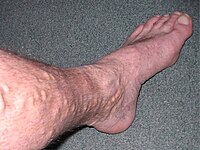
Photo from wikipedia
OBJECTIVE To outline treatment considerations and outcomes for a cohort of patients with forniceal rupture with the aim of adding to a very limited body of literature regarding clinical practice… Click to show full abstract
OBJECTIVE To outline treatment considerations and outcomes for a cohort of patients with forniceal rupture with the aim of adding to a very limited body of literature regarding clinical practice in this area. METHODS We retrospectively searched all radiographic records for patients treated at our institution between January 2009 and January 2016 with forniceal rupture. We compiled demographic data, etiology, clinical factors, treatments, and outcomes. RESULTS Of the 103 patients analyzed, the median age at presentation was 64 years (interquartile range 52-73), and 56 (54%) were female. The etiology of forniceal rupture was most commonly urolithiasis (73%), with cancer being the next most common cause (11%). Most cases (61%) were caused by small (1-5 mm) stones in the distal ureter. Thirty-one patients (30%) were treated surgically with ureteral stent placement upfront; 27 of those patients had a ureteral stone, and most had some clinical factors making them higher risk. There was only 1 operative complication during the study period. Only 1 patient developed an abscess. Forty-three patients (42%) were sent home from the emergency room. Of the patients who were admitted, the average hospital stay was 3 days (interquartile range 2-6). For the entire cohort, there were 6 (6%) readmissions in the study period. CONCLUSION Very limited data exist in the literature regarding clinical practice in the treatment of forniceal rupture. Clinical practice at our institution is conservative treatment of forniceal rupture in the absence of infection, kidney failure, or other risk factors with few complications or readmissions.
Journal Title: Urology
Year Published: 2017
Link to full text (if available)
Share on Social Media: Sign Up to like & get
recommendations!